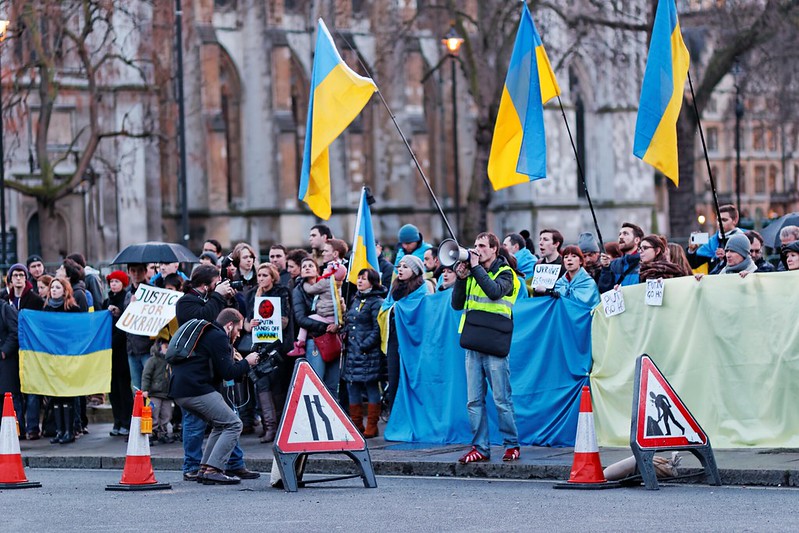Vladimir Putin’s threat to invade Ukraine forces all parties to make their calculations with three fundamental variables. The first two have dominated public debate so far: the preparedness of Russia to go to war, and the possible impact of Western sanctions in reply. But there is third variable, arguably the most important of all, namely how Ukraine – its leadership and population – see their future, and within that the key role of the EU.
Putin’s overarching objectives are clear: for Ukraine to fail in its Westernisation and Europeanisation, and to obtain guarantees against its accession to NATO. His tactics on the other hand are deliberately unclear, manifestly threatening war while denying it. Why now, the urgency of scaling up the threat? Is he bluffing? Putin is obsessed by his ambition to regain Ukraine, sees that with time his chances of doing so will decline as Ukraine pivots West and towards Europe, and that with Joe Biden prioritising confrontation with China, now is his best opportunity. He would of course prefer to secure his objectives without war. The current military build-up serves in any case to get a clearer view of the US’s bottom line over war, and to gain leverage in possible negotiations over a revised European security order. Thus far, Putin is getting results, namely Biden’s statement that the US will not go to war, and that he is willing to discuss Russia’s concerns over NATO.
However, the threat of war remains, but probably limited in two respects – territorially and conditionally. Least implausibly, one can imagine the Kremlin planners eyeing a lightning strike first to take Mariupol and then to advance further down the coast of the Azov Sea, taking Berdiansk and Melitopol to join up with Crimea – then back to Novorossiya. The territorial gains might extend inland to the banks of the Dnipro River, so to gain control of the North Crimea Canal, currently blocked by Ukraine, and restore badly needed water supplies for Crimea. Pulling the trigger would depend on whether Ukraine can be provoked into an ill-judged action, sufficient to serve as pretext for such a military campaign. This would be drawing on the model of the 2008 war with Georgia, to which Sergei Lavrov even referred explicitly in recent days saying that the territorial gains would be much bigger.
What might be the sanctions of the US and EU in reply? Qualitatively, the language is about them being devastating, but the specifics are not that clear or that threatening for the Kremlin. Nord Stream 2 is mentioned. But there is still Nord Stream 1 and gas pipelines going through Ukraine. A total blockage of Russian gas by the EU would hurt Russia a lot, and the EU could accelerate plans and investments to prepare for this. Still, this can only be a medium-term plan, not for this winter in current gas-market conditions. There is also talk of cutting Russia out of SWIFT financial transactions, which would be inconvenient but hardly devastating. Russia would be cast as a pariah state by the G7, but it is virtually so already for the West, and can count on support from China. Overall Russia is relatively well placed to survive the probable enhanced sanctions.
This leaves the third variable, which is where Ukraine as a state and society has got to over the last decade or so, and where it is heading and notably with the EU. Russia’s main fear has to be that its threats only increase the alienation of Ukrainian society, 72% of which, according to a recent poll, already consider Russia to be a hostile power. A limited military invasion is unlikely to produce a pro-Russian coup d’état in Kyiv, and a wholesale military conquest is not plausible for the Kremlin’s realistic planning.
Ukraine nonetheless remains a fragile state, with European orientations of uncertain strength, seeking membership prospects from the EU but not getting them. The EU is in no condition to suddenly switch into EU pre-accession mode with Ukraine. But decisive steps could be taken to credibly upgrade Ukraine’s deepening economic, political and societal integration with the EU. The stakes are so high now with the Russian threats that a step change, or change of gear, is warranted and feasible. The EU has the instruments in its hands and the framework conditions governing EU-Ukraine relations are in place. Two examples can illustrate this.
First is the already established ‘more for more’ principle, in which financial assistance would be increased on condition that policy criteria are met. The problem is that today this is still too vague to be a major driver of policy reform. Yet it could be transformed as a matter now of geopolitical priority. The two parties should sit down together to work out a big plan.
This leads to a second concrete opportunity, namely to persuade Ukraine to join in the EU’s Green Deal, which could have an even bigger transformative impact on Ukraine than for the EU itself. A high-level joint task force is already at work asking the right questions, with the EU ready to create a ‘financing platform’, together with others, meaning the US and international financial institutions. The EU and US could together create a 2+1 overarching strategic platform with Ukraine, embracing both the Green Deal and other policy dimensions, and also a wider G7+1 platform.
These propositions would be entirely consistent with the conclusions of the Eastern Partnership summit of 15 December, but converted in the case of Ukraine into a strategic and concrete reality.


